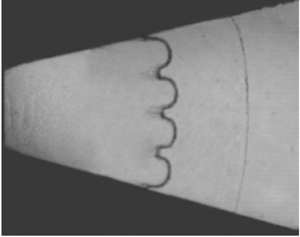Crossref Citations
This article has been cited by the following publications. This list is generated based on data provided by
Crossref.
Ge, Jin
Zhang, Xin-ting
Li, Hai-feng
and
Tian, Bao-lin
2020.
Late-time turbulent mixing induced by multimode Richtmyer–Meshkov instability in cylindrical geometry.
Physics of Fluids,
Vol. 32,
Issue. 12,
Cheng, Lidong
Deng, Xi
Xie, Bin
Jiang, Yi
and
Xiao, Feng
2021.
Low-dissipation BVD schemes for single and multi-phase compressible flows on unstructured grids.
Journal of Computational Physics,
Vol. 428,
Issue. ,
p.
110088.
Zhou, Ye
Williams, Robin J.R.
Ramaprabhu, Praveen
Groom, Michael
Thornber, Ben
Hillier, Andrew
Mostert, Wouter
Rollin, Bertrand
Balachandar, S.
Powell, Phillip D.
Mahalov, Alex
and
Attal, N.
2021.
Rayleigh–Taylor and Richtmyer–Meshkov instabilities: A journey through scales.
Physica D: Nonlinear Phenomena,
Vol. 423,
Issue. ,
p.
132838.
Liu, Y.
and
Guan, Y. K.
2021.
Large eddy simulation of the turbulent mixing at an oblique interface induced by non-classical planar shock waves.
AIP Advances,
Vol. 11,
Issue. 4,
Wang, He
Zhai, Zhigang
and
Luo, Xisheng
2022.
Prediction of triple point trajectory on two-dimensional unsteady shock reflection over single surfaces.
Journal of Fluid Mechanics,
Vol. 947,
Issue. ,
Liang, Yu
Liu, Lili
Luo, Xisheng
and
Wen, Chih-Yung
2023.
Hydrodynamic instabilities of a dual-mode air–SF6 interface induced by a cylindrically convergent shock.
Journal of Fluid Mechanics,
Vol. 963,
Issue. ,
Zhang, Duo
Ding, Juchun
Si, Ting
and
Luo, Xisheng
2023.
Divergent Richtmyer–Meshkov instability on a heavy gas layer.
Journal of Fluid Mechanics,
Vol. 959,
Issue. ,
Zhang, Duo
Ding, Juchun
Li, Ming
Zou, Liyong
and
Luo, Xisheng
2023.
Effects of reverberating waves and interface coupling on a divergent Richtmyer–Meshkov instability.
Journal of Fluid Mechanics,
Vol. 975,
Issue. ,
Xu, Jinru
Wang, He
Zhai, Zhigang
and
Luo, Xisheng
2023.
Convergent Richtmyer–Meshkov instability on two-dimensional dual-mode interfaces.
Journal of Fluid Mechanics,
Vol. 965,
Issue. ,
Musci, Benjamin
Olson, Britton
Petter, Samuel
Pathikonda, Gokul
and
Ranjan, Devesh
2023.
Multifidelity validation of digital surrogates using variable-density turbulent mixing models.
Physical Review Fluids,
Vol. 8,
Issue. 1,
Singh, Satyvir
and
Battiato, Marco
2023.
Numerical investigation of shock Mach number effects on Richtmyer–Meshkov instability in a heavy square bubble.
Physica D: Nonlinear Phenomena,
Vol. 453,
Issue. ,
p.
133844.
Li, Jiaxuan
Wang, He
Zhai, Zhigang
and
Luo, Xisheng
2023.
Richtmyer–Meshkov instability of a single-mode heavy–light interface in cylindrical geometry.
Physics of Fluids,
Vol. 35,
Issue. 10,
Zhai, Zhigang
Xu, Jinru
and
Luo, Xisheng
2024.
Convergent Richtmyer-Meshkov instability on two-dimensional tri-mode interfaces.
Science China Physics, Mechanics & Astronomy,
Vol. 67,
Issue. 12,
Ding, Juchun
Zhang, Duo
and
Luo, Xisheng
2024.
Divergent Richtmyer–Meshkov instability under different shock strengths.
Journal of Fluid Mechanics,
Vol. 987,
Issue. ,
Pascoe, B.
Groom, M.
Youngs, D.L.
and
Thornber, B.
2024.
Impact of axial strain on linear, transitional and self-similar turbulent mixing layers.
Journal of Fluid Mechanics,
Vol. 999,
Issue. ,




